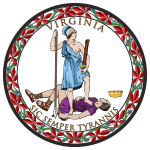| ||||||||||||||||||||||||||
| ||||||||||||||||||||||||||
 County Results
| ||||||||||||||||||||||||||
| ||||||||||||||||||||||||||
| Elections in Virginia |
|---|
 |
The 1952 United States presidential election in Virginia took place on November 4, 1952. Voters chose twelve representatives, or electors to the Electoral College, who voted for president and vice president.
For the previous five decades Virginia had almost completely disenfranchised its black and poor white populations through the use of a cumulative poll tax and literacy tests.[2] So restricted was suffrage in this period that it has been calculated that a third of Virginia's electorate during the first half of the twentieth century comprised state employees and officeholders.[2]
This limited electorate allowed Virginian politics to be controlled for four decades by the Byrd Organization, as progressive “antiorganization” factions were rendered impotent by the inability of almost all their potential electorate to vote.[3] Historical fusion with the “Readjuster” Democrats,[4] defection of substantial proportions of the Northeast-aligned white electorate of the Shenandoah Valley and Southwest Virginia over free silver,[5] and an early move towards a “lily white” Jim Crow party[4] meant Republicans retained a small but permanent number of legislative seats and local offices in the western part of the state.[6] In 1928 a combination of growing middle-class Republicanism in the cities and anti-Catholicism against Al Smith in the Tidewater[7] allowed the GOP to carry Virginia and elect three Congressmen, including one representing the local district of emerging machine leader Byrd.[8] However, from 1932 with the state severely affected by the Depression, Republican strength declined below its low pre-1928 level, although Byrd himself became highly critical of Franklin D. Roosevelt’s New Deal policies as early as 1940.[9]
Largely because of fear of losing several seats in the House to resurgent Republicans, Virginia's federal officeholders, although all firmly opposed to Harry S. Truman’s civil rights bills, did not endorse Strom Thurmond in 1948.[10] However, Byrd became almost completely opposed to the Truman administration’s policies during the ensuing presidential term,[11] and after initially preferred nominee Richard Russell Jr. called for repealing the Taft–Hartley Act, the Byrd Organization refused to endorse any Democratic nominee,[11] explicitly rejecting eventual nominees Illinois Governor Adlai Stevenson II and Alabama Senator John Sparkman.[12]
- ^ "U.S. presidential election, 1952". Facts on File. Archived from the original on October 29, 2013. Retrieved October 24, 2013.
Eisenhower, born in Texas, considered a resident of New York, and headquartered at the time in Paris, finally decided to run for the Republican nomination
- ^ a b Kousser, J. Morgan (1974). The Shaping of Southern Politics: Suffrage Restriction and the Establishment of the One-Party South, 1880-1910. Yale University Press. pp. 178–181. ISBN 0-300-01696-4.
- ^ Key, Valdimer Orlando (1949). Southern Politics in State and Nation. pp. 20–25.
- ^ a b Heersink, Boris; Jenkins, Jeffrey A. (March 19, 2020). Republican Party Politics and the American South, 1865-1968. Cambridge University Press. pp. 217–221. ISBN 978-1107158436.
- ^ Moger, Allen. "The Rift in Virginia Democracy in 1896". The Journal of Southern History. 4 (3): 295–317. doi:10.2307/2191291. JSTOR 2191291.
- ^ Phillips, Kevin P. (1969). The Emerging Republican Majority. Arlington House. pp. 193, 219. ISBN 0870000586.
- ^ Phillips. The Emerging Republican Majority, p. 195
- ^ Hawkes (junior), Robert T. (July 1974). "The Emergence of a Leader: Harry Flood Byrd, Governor of Virginia, 1926-1930". The Virginia Magazine of History and Biography. 82 (3): 259–281.
- ^ Davidson, Chandler; Grofman, Bernard (1994). Quiet revolution in the South: the impact of the Voting rights act, 1965-1990. Princeton University Press. pp. 275–276. ISBN 0691032475.
- ^ Guthrie, Paul Daniel (1955). The Dixiecrat Movement of 1948 (Thesis). Bowling Green State University. pp. 179–181. Docket 144207.
- ^ a b Sweeney, J.R. (1978). "Revolt in Virginia: Harry Byrd and the 1952 presidential election". Virginia Magazine of History and Biography. 86 (2). Old Dominion University: 180–195.
- ^ Grant Jr., Philip A. (Spring 1990). "Eisenhower and the 1952 Republican Invasion of the South: The Case of Virginia". Presidential Studies Quarterly. 20 (2) (Eisenhower Centennial Issue ed.): 285–293.


